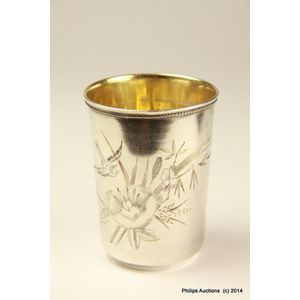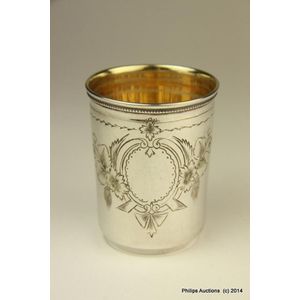Russian Silver Charka, Late 19th Century
You must be a subscriber, and be logged in to view price and dealer details.
Subscribe Now to view actual auction price for this item
When you subscribe, you have the option of setting the currency in which to display prices to $Au, $US, $NZ or Stg.
- Cartouche - An ornamental panel in the form of of a shield, oval or rectangular scroll with curling edges. It may be carved into the back of a chair or the top of a sideboard, or present on a piece of silver or jewellery, and contain the initials of the original owner, heraldic symbols, or some other inscription, such as the details of a presentation.
In ceramics the term defines the central area of a vase or similar with a decorative border in one of the shapes above, into which a decorative scene or figures have been painted. - Hallmarks - A mark stamped on articles of precious metals in Britain, since the 14th century, certifying their purity. It derives its name from the Guild Hall of the Goldsmiths' Company, who recieved its Charter in 1327 giving it the power to assay (test the purity) and mark articles of gold and silver.
The hallmark will consist of several marks, including the:
- silver standard mark, indicating the purity of the metal. Sterling silver is .925 pure silver.
- the city mark indicating the city in which it was assayed eg London, Birmingham, York etc.
- the date mark, usually a letter of the alphabet in a particular font and case,
- a duty mark, indicating whether duty had been paid to the crown, and only in use from 1784 to 1890
The piece may include an additional mark, the maker's mark, although not forming part of the hallmark, will be located in the vicinity of the hallmarks.
Sometimes silver plated items will bear faux hallmarks, often confusing those not familiar with silver markings. - Circa - A Latin term meaning 'about', often used in the antique trade to give an approximate date for the piece, usually considered to be five years on either side of the circa year. Thus, circa 1900 means the piece was made about 1900, probably between 1895 and 1905. The expression is sometimes abbreviated to c.1900.
This item has been included into following indexes:
Visually similar items

A Russian silver charka. 1896-1908, with 84 and maker's mark Aa. a straight sided beaker with a gilt washed interior, having a slightly everted and beaded rim, with a delicately engraved image of a bird flying over a flower and rushes; hallmarked underside

A Victorian sterling silver sugar bowl with gilt interior, chinoiserie style foliate decoration to the body. Hallmarked of Martin Hall & Co. London, 1881. 6.5 cm high, 11 cm diameter, 168gm. Provenance: Originally purchased at the London silver vaults and

A Russian silver cup measure., of tapering cylindrical form with engraved 'Village' scene back and front. Additional scroll and foliate decoration. Russian hallmarks, circa 1860.

A Victorian silver bowl, maker William Gibson & John Lawrence Langman London 1884 the bowl with gilt interior, the body chased with panels between bands of leaves. 133 gm. 7.5 cm high
